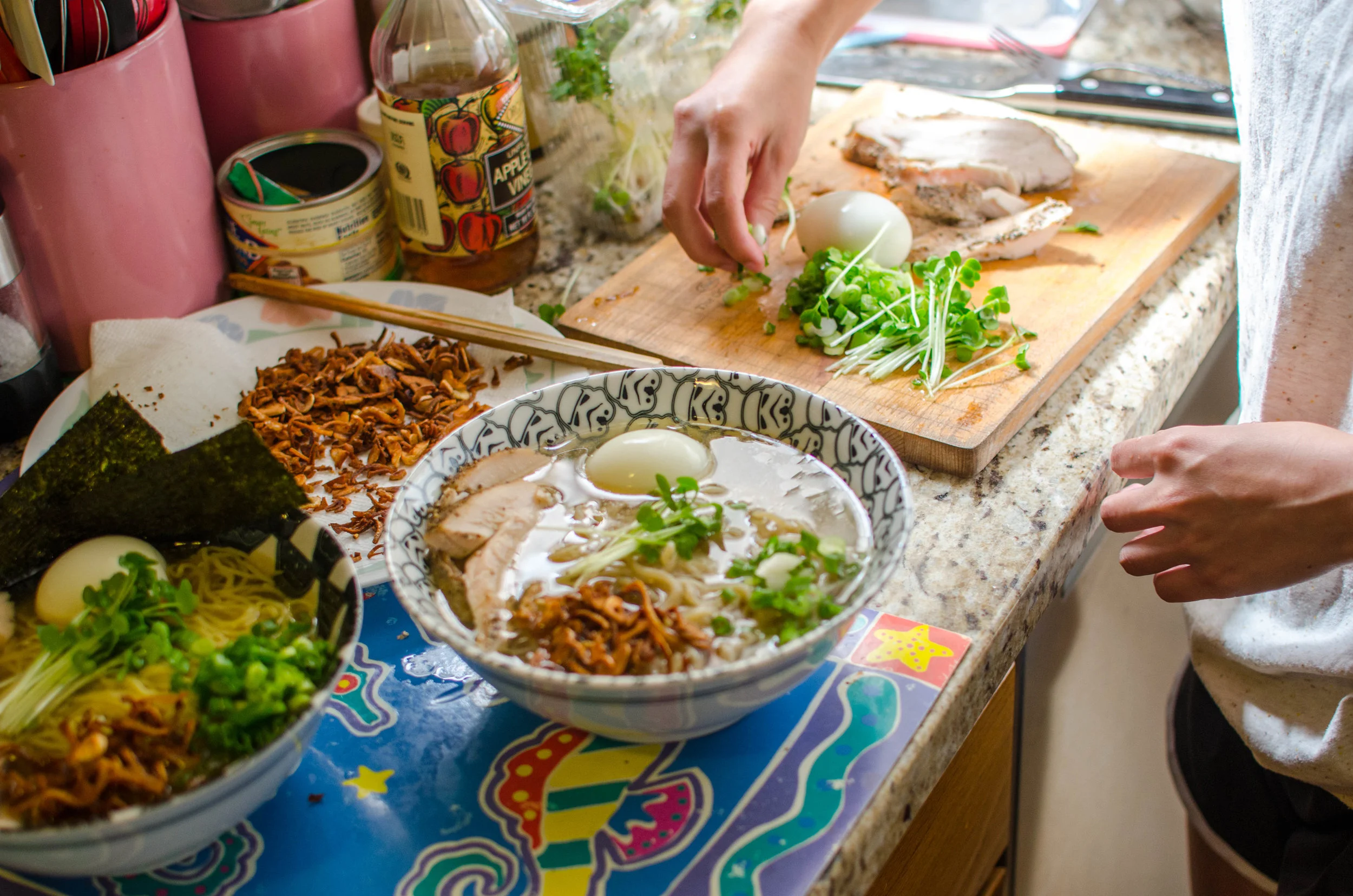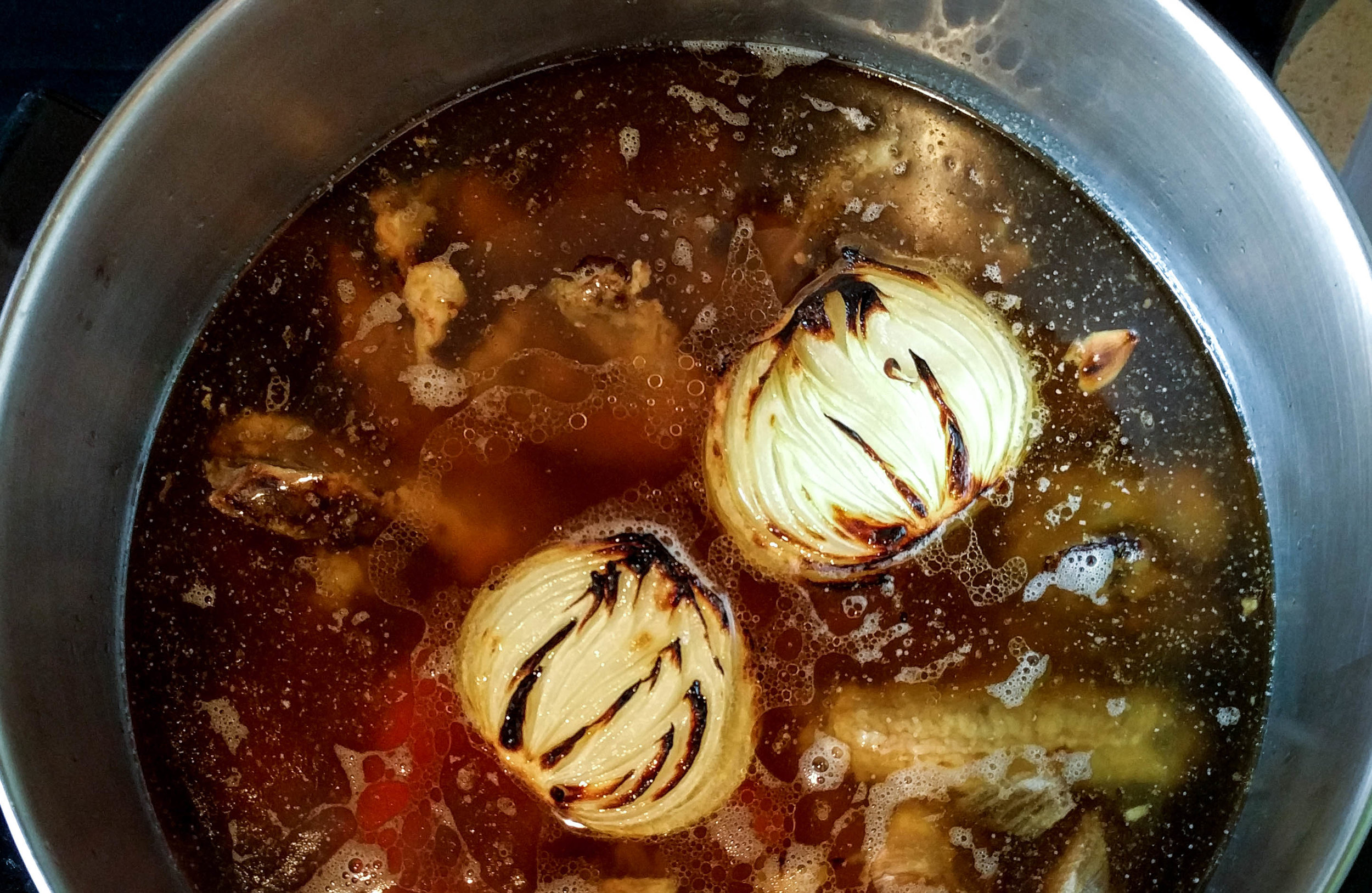//basics of ramen
Ramen is a Japanese noodle soup dish with Chinese-style alkaline noodles. It is the harmony of five key elements of ramen: broth, tare (sauce), noodles, toppings, and oil.
//broth
The Soul of the Bowl
The broth is the foundation of any good ramen bowl. It bestows the literal and figurative heart warming quality to a good bowl of ramen. With a hearty sip from a good broth, your body will let out a sight happiness, "Ahhh~". The soup starts with base ingredients that are often composed of chicken, pork, seafood, and/or vegetables. The key to a good broth is to extract flavor and body from ingredients.
Flavor tends to be extracted from meat and vegetables, while the body or mouthfeel of the soup comes from connective tissue, fat, and bones.
All in the Details
Like the people who drink it, Ramen broth has different personalities and colors. There are chintan (清湯) or "clear soups", which are extract from ingredients at a low temperature and are commonly found in shio and shoyu ramen. On the other end of the spectrum there are paitan (白湯) or "white soup" broths such as tonkotsu ramen or tori paitan. To achieve their thick and cloudy characteristics, ingredents must be heated at higher temperatures to create emulsions between the higher collagen and fat content.
//tare
Working Behind the Scenes
The tare is the sauce or seasoning for the broth and provides a lot of the umami and saltiness to the soup that not many people know about. This is the secret weapon for every ramen chef that is literally a secret. Common ingredients used for the tare consist of soy sauce, wine, sake, kombu (kelp), niboshi (dried sardines), miso, or salt, just to name a few. Without the tare, the broth would just be meaty soup water. Not the most appealing thing in the world.
What's in a name?
Ramen is often prefaced by the name of tare used: Shio Ramen (salt tare), Shoyu Ramen (Soy Sauce Tare), Miso Ramen (Miso Tare). If ramen types were houses at Hogwarts, the tare would be one of the main characteristics the sorting hat would look at. There are many exceptions such as tonkotsu ramen and tan tan men, so I don't know how well my Harry Potter analogy holds.
//noodles
While the broth provides the soul to a Ramen bowl, the noodles differentiate ramen from any other noodle soup dish. Ramen noodles at its core is composed of water, wheat flour, and kansui (枧水) or alkaline water. The water and wheat form the structure of the noodles through starch and gluten bonds, while the kansui interacts with the protein in the flour which give the noodles their distinct chewy texture and yellow hue. Salt is often added which brings out a little bit of flavor of the noodle and strengthens the structure. Eggs can be added in their fresh or powdered form to add tenderness and bounce from their proteins and fat.
The difficult aspect of making noodles is getting the ratio right for the style of ramen. Many restaurants even in Japan buy their noodles. Hakata Tonkotsu style noodles are pales, straight and thing while Tokyo style noodles are curly and yellow. The texture and flavor of noodles are determined by the ratio of flour to water to alkaline salts or solution. It is also highly dependent on many other factors such as protein content of the flour, hardness of water, and composition of the alkaline salts used, just to name a few. The process is very frustrating for amateur cooks, but very rewarding when done correctly.
//toppings
Toppings are the clothes equivalent for ramen. They can flashy and eye catching to provide a unique experience or plain, simple, and classic. The most common consist of chashu, green onions, menma (bamboo shoots), seaweed, and the prized ajitsuke tamago (marinated egg).
Just like with fashion, everyone has their own opinion of what is the best way to dress their ramen. Many restaurants allow the customers to accessorize their bowl add additional toppings.
//Oil
The oil on the surface of a bowl of ramen is often overlooked as a key component of the dish. Oil is flavored with garlic and other aromatics and added to the surface of the broth. The hydrophobic nature of oil provides it with a greater capacity to extract flavors that are are lost in water.
When noodles are immersed the in the broth, they are coated by the flavored oil and take on a smooth texture when swallowed. Oil also acts as an insulator or lid to the bowl of ramen and prevent the temperature from dropping quickly.





